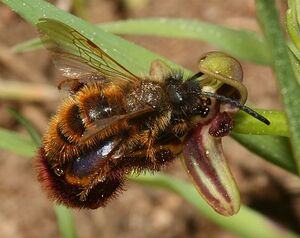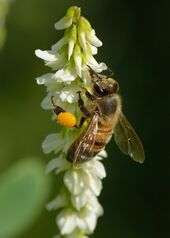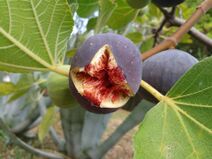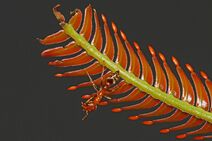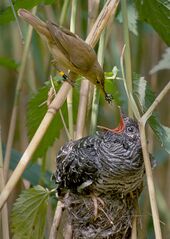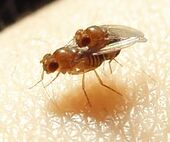“共同演化”的版本间的差异
| 第3行: | 第3行: | ||
{{Short description|Two or more species influencing each other's evolution}} | {{Short description|Two or more species influencing each other's evolution}} | ||
{{Good article}} | {{Good article}} | ||
| − | [[File:Dasyscolia ciliata.jpg|thumb|授粉的黄蜂 ''Dasyscolia ciliata'' 在与''Ophrys speculum'' | + | [[File:Dasyscolia ciliata.jpg|thumb|授粉的黄蜂''[[wikipedia:Dasyscolia_ciliata|Dasyscolia ciliata]]''在与''[[wikipedia:Ophrys_speculum|Ophrys speculum]]''的一朵花进行[[wikipedia:Pseudocopulation|拟交配]]<ref name=Pijl/>|链接=Special:FilePath/Dasyscolia_ciliata.jpg|替代=]] |
{{Evolutionary biology}} | {{Evolutionary biology}} | ||
| 第26行: | 第26行: | ||
====昆虫和昆虫传粉的花朵==== | ====昆虫和昆虫传粉的花朵==== | ||
{{Further|Entomophily}} | {{Further|Entomophily}} | ||
| − | [[File:Apis mellifera - Melilotus albus - Keila.jpg|thumb| | + | [[File:Apis mellifera - Melilotus albus - Keila.jpg|thumb|[[wikipedia:Honey_bee|蜜蜂]]在[[wikipedia:Melilotus_albus|白草木犀属]]花朵的[[wikipedia:Pollen_basket|花粉筐]]中采集花粉并获得[[wikipedia:Nectar|奖励花蜜]]|链接=Special:FilePath/Apis_mellifera_-_Melilotus_albus_-_Keila.jpg|238x238像素]] |
现代[[wikipedia:Entomophily|昆虫传粉(虫媒)的花朵]]明显与昆虫相互适应以确保授粉,并以花蜜和花粉回馈[[wikipedia:Pollinator|授粉者]];这两组群体已经共同演化了超过1亿年,创造了一个复杂的互动网络;它们要么一同演化,要么在后期的某些阶段一同演化——并很可能伴随着预适应,在之后达到了如此充分的相互适应性。<ref name="Lunau">{{cite journal |last1=Lunau |first1=Klaus |title=Adaptive radiation and coevolution — pollination biology case studies |journal=Organisms Diversity & Evolution |date=2004 |volume=4 |issue=3 |pages=207–224 |doi=10.1016/j.ode.2004.02.002 }}</ref><ref>{{cite book |author=Pollan, Michael |title=The Botany of Desire: A Plant's-eye View of the World |publisher=Bloomsbury |isbn=978-0-7475-6300-6 |title-link=The Botany of Desire |year=2003}}</ref> | 现代[[wikipedia:Entomophily|昆虫传粉(虫媒)的花朵]]明显与昆虫相互适应以确保授粉,并以花蜜和花粉回馈[[wikipedia:Pollinator|授粉者]];这两组群体已经共同演化了超过1亿年,创造了一个复杂的互动网络;它们要么一同演化,要么在后期的某些阶段一同演化——并很可能伴随着预适应,在之后达到了如此充分的相互适应性。<ref name="Lunau">{{cite journal |last1=Lunau |first1=Klaus |title=Adaptive radiation and coevolution — pollination biology case studies |journal=Organisms Diversity & Evolution |date=2004 |volume=4 |issue=3 |pages=207–224 |doi=10.1016/j.ode.2004.02.002 }}</ref><ref>{{cite book |author=Pollan, Michael |title=The Botany of Desire: A Plant's-eye View of the World |publisher=Bloomsbury |isbn=978-0-7475-6300-6 |title-link=The Botany of Desire |year=2003}}</ref> | ||
| − | 一些非常成功的[[wikipedia:Insect|昆虫]]群体——尤其是[[wikipedia:Hymenoptera|膜翅目]](黄蜂、蜜蜂和蚂蚁)和[[wikipedia:Lepidoptera|鳞翅目]](蝴蝶和飞蛾)以及许多种[[wikipedia:Diptera|双翅目]](苍蝇)和[[wikipedia:Coleoptera|鞘翅目]](甲虫)——在[[Cretaceous|白垩纪]](1.45亿至6.6亿年前)与[[ | + | 一些非常成功的[[wikipedia:Insect|昆虫]]群体——尤其是[[wikipedia:Hymenoptera|膜翅目]](黄蜂、蜜蜂和蚂蚁)和[[wikipedia:Lepidoptera|鳞翅目]](蝴蝶和飞蛾)以及许多种[[wikipedia:Diptera|双翅目]](苍蝇)和[[wikipedia:Coleoptera|鞘翅目]](甲虫)——在[[wikipedia:Cretaceous|白垩纪]](1.45亿至6.6亿年前)与[[wikipedia:Flowering_plant|被子植物]]共同演化;最早的蜜蜂,今天重要的传粉者,出现在白垩纪早期。<ref name="Bristol">{{cite web |title=Coevolution of angiosperms and insects |url=http://palaeo.gly.bris.ac.uk/Palaeofiles/Angiosperms/coevolution.htm |publisher=University of Bristol Palaeobiology Research Group |access-date=16 January 2017 |archive-url=https://web.archive.org/web/20161220033247/http://palaeo.gly.bris.ac.uk/Palaeofiles/Angiosperms/coevolution.htm |archive-date=20 December 2016 |url-status=dead }}</ref>一群与蜜蜂相[[wikipedia:Sister_clade|近亲]]的黄蜂与被子植物同时演化,鳞翅目也是如此;<ref name="Bristol" />此外,所有主要的蜜蜂[[wikipedia:Clade|分支种系]]均首次出现在白垩纪中到晚期间,同时出现的是[[wikipedia:Eudicots|真双子叶植物]]的辐射适应(占所有被子植物的四分之三) ,正当被子植物成为世界上陆地的主要植物时。<ref name="CardinalDanforth2013">{{cite journal |last1=Cardinal |first1=Sophie |last2=Danforth |first2=Bryan N. |title=Bees diversified in the age of eudicots |journal=Proceedings of the Royal Society B |date=2013 |doi=10.1098/rspb.2012.2686 |volume=280 |issue=1755 |pages=20122686 |pmid=23363629 |pmc=3574388}}</ref> |
| − | 被子植物的花至少在三个方面呈现出和昆虫的共同演化,因为它们涉及到了这些有机体之间的交流;首先,花朵通过气味与它们的传粉者交流,昆虫通过这种气味来确定与一朵花的距离和靠近它,并决定在哪落足以及到最后在哪觅食;其次,吸引昆虫的花纹和图案导向花蜜和花粉的奖励,而蓝色和紫外线等色调则面向视觉灵敏的诱导授粉的目标;与此相对的是,通过鸟类传粉的花朵会更倾向于是红色或橙色的;再次,像[[Ophrys|某些兰花]]这样的花朵会模仿某些昆虫的雌性,欺骗雄性进入[[ | + | 被子植物的花至少在三个方面呈现出和昆虫的共同演化,因为它们涉及到了这些有机体之间的交流;首先,花朵通过气味与它们的传粉者交流,昆虫通过这种气味来确定与一朵花的距离和靠近它,并决定在哪落足以及到最后在哪觅食;其次,吸引昆虫的花纹和图案导向花蜜和花粉的奖励,而蓝色和紫外线等色调则面向视觉灵敏的诱导授粉的目标;与此相对的是,通过鸟类传粉的花朵会更倾向于是红色或橙色的;再次,像[[wikipedia:Ophrys|某些兰花]]这样的花朵会模仿某些昆虫的雌性,欺骗雄性进入[[wikipedia:Pseudocopulation|拟交配]]。<ref name="Bristol" /><ref name="Pijl">{{cite book |first1=Leendert |last1=van der Pijl |first2=Calaway H. |last2=Dodson |title=Orchid Flowers: Their Pollination and Evolution |chapter-url=https://archive.org/details/orchidflowersthe0000pijl |chapter-url-access=registration |chapter=Chapter 11: Mimicry and Deception |publisher=[[University of Miami]] Press |location=Coral Gables |year=1966 |pages=[https://archive.org/details/orchidflowersthe0000pijl/page/129 129–141] |isbn=978-0-87024-069-0}}</ref> |
| − | 对[[ | + | 对[[wikipedia:Yucca|丝兰]](''Yucca whipplei'')这种植物只有斑点豆斑蛾才能够为其授粉,而斑点豆斑蛾是一种依靠丝兰生存的[[wikipedia:Yucca_moth|丝兰蛾]],<ref>{{cite journal |title=Pollination Partnerships Fact Sheet |journal=Flora of North America |year=2004 |first=Claire |last=Hemingway |pages=1–2 |url=http://www.fna.org/files/imported/Outreach/FNAfs_yucca.pdf |access-date=2011-02-18 |quote=Yucca and Yucca Moth}}</ref><ref>{{cite journal |doi=10.1073/pnas.96.16.9178 |title=Forty million years of mutualism: Evidence for Eocene origin of the yucca-yucca moth association |journal=Proc. Natl. Acad. Sci. USA |date=August 1999 |first=Olle |last=Pellmyr |pmid=10430916 |author2=James Leebens-Mack |volume=96 |issue=16 |pmc=17753 |pages=9178–9183 |bibcode=1999PNAS...96.9178P|doi-access=free }}</ref>花粉会随附在蛾进食植物的种子的过程之中被采集;花粉已经进化得非常粘着,当飞蛾移动到下一朵花时仍然会留在其口腔的部分;丝兰则在花的深处为蛾提供了一个产卵的地方,来远离潜在的捕食者。 |
====鸟类和鸟类传粉的花朵==== | ====鸟类和鸟类传粉的花朵==== | ||
{{Further|Ornithophily}} | {{Further|Ornithophily}} | ||
| − | [[File:Purple-throated carib hummingbird feeding.jpg|thumb|left| | + | [[File:Purple-throated carib hummingbird feeding.jpg|thumb|left|[[wikipedia:Purple-throated_carib|紫喉蜂鸟]]在从一朵花中摄食并授粉|链接=Special:FilePath/Purple-throated_carib_hummingbird_feeding.jpg|212x212像素]] |
| − | [[Hummingbird|蜂鸟]]和喜鸟类(通过鸟类传粉)的花演化出了一种[[ | + | [[wikipedia:Hummingbird|蜂鸟]]和喜鸟类(通过鸟类传粉)的花演化出了一种[[wikipedia:Mutualism_(biology)|互惠]]的关系;这些花的[[wikipedia:Nectar|花蜜]]合于鸟类的饮食,它们的颜色亦合于鸟类的视觉,它们的形状则合于鸟的喙;这些花的开放时间还被发现与蜂鸟的繁殖季节相吻合;同与被昆虫传粉密切相关的植物相比,喜鸟类植物的花部特征差异很大;这些花也会较昆虫授粉的同类更华丽、复杂和艳丽;被普遍认为的是,植物首先与昆虫形成共同演化关系,喜鸟类植物在后期分化;从鸟类学到昆虫授粉,并没有多少科学依据支持此分歧中相反的例子;喜鸟类植物花器官表型的多样性和蜜蜂传粉物种花器官表型的相对一致性可以归因于传粉者偏好的转变方向。<ref>{{cite journal |last1=Kay |first1=Kathleen M.|last2=Reeves |first2=Patrick A. |last3=Olmstead |first3=Richard G. |last4=Schemske|first4=Douglas W. |s2cid=2991957|title=Rapid speciation and the evolution of hummingbird pollination in neotropical Costus subgenus Costus (Costaceae): evidence from nrDNA ITS and ETS sequences |journal=American Journal of Botany |date=2005 |volume=92 |issue=11|pages=1899–1910 |doi=10.3732/ajb.92.11.1899 |pmid=21646107|doi-access=free }}</ref> |
| − | 花朵聚集在一起以利用同类鸟的优势;<ref name="Brown">{{cite journal |title=Convergence, Competition, and Mimicry in a Temperate Community of Hummingbird-Pollinated Flowers|author1=Brown James H. |author2=Kodric-Brown Astrid |s2cid=53604204 |journal=Ecology |year=1979 |volume=60 |issue=5 |pages=1022–1035 |doi=10.2307/1936870|jstor=1936870}}</ref>花朵为了传粉者而相互竞争,而适应性减少了这种竞争的不利影响;鸟类可以在恶劣天气下飞行,这一事实使它们在蜜蜂和其他昆虫不活跃的地方成为更有效的授粉者;由于这个原因,鸟媒花在处在昆虫定居或植物较少的孤立环境中的冬季开放的花朵中更容易会出现;<ref name="Brown" /><ref>{{cite journal |last1=Cronk |first1=Quentin |last2=Ojeda |first2=Isidro |title=Bird-pollinated flowers in an evolutionary and molecular context |journal=Journal of Experimental Botany |date=2008 |volume=59 |issue=4 |pages=715–727 |doi=10.1093/jxb/ern009|pmid=18326865|doi-access=free }}</ref>鸟类传粉的花朵通常比昆虫传粉的花朵有更多的花蜜和更高的糖分产量。<ref name="Stiles">{{cite journal |title=Geographical Aspects of Bird Flower Coevolution, with Particular Reference to Central America |author=Stiles, F. Gary |journal=Annals of the Missouri Botanical Garden |year=1981 |volume=68 |issue=2 |pages=323–351 |doi=10.2307/2398801|jstor=2398801|url=https://www.biodiversitylibrary.org/part/38387 }}</ref>这也正迎合了鸟类高能量的需求,作为了花在面临自然选择时最重要的决定因素<ref name="Stiles" />;在''[[Mimulus|沟酸浆属]]''中,花瓣中红色素和花蜜产量的增加明显减少了蜜蜂授粉的比例,而对于蜂鸟则相反;同时花朵表面积越大蜜蜂授粉的比例也就越高;因此,红雀花中的红色色素可能主要起到抑制蜜蜂拜访的作用;<ref>{{cite journal |last1=Schemske |first1=Douglas W. |last2=Bradshaw |first2=H.D. |title=Pollinator preference and the evolution of floral traits in monkeyflowers (''Mimulus'') |journal=Proceedings of the National Academy of Sciences |date=1999 |volume=96 |issue=21 |pages=11910–11915 |doi=10.1073/pnas.96.21.11910|pmid=10518550 |bibcode=1999PNAS...9611910S |pmc=18386|doi-access=free }}</ref>在''[[Penstemon|钓钟柳]]''中,阻碍蜜蜂授粉的花朵特征可能比“支持鸟类”的适应性对花朵进化变化的影响更大,但是“亲和”鸟类和“疏离”蜜蜂的适应性变化可以同时发生<ref>{{cite journal |last1=Castellanos|first1=M. C. |last2=Wilson |first2=P. |last3=Thomson |first3=J.D. |title='Anti-bee' and 'pro-bird' changes during the evolution of hummingbird pollination in Penstemon flowers |journal=Journal of Evolutionary Biology |date=2005 |volume=17 |issue=4 |pages=876–885 |doi=10.1111/j.1420-9101.2004.00729.x |pmid=15271088|doi-access=free }}</ref>;然而,一些花,如''[[ | + | 花朵聚集在一起以利用同类鸟的优势;<ref name="Brown">{{cite journal |title=Convergence, Competition, and Mimicry in a Temperate Community of Hummingbird-Pollinated Flowers|author1=Brown James H. |author2=Kodric-Brown Astrid |s2cid=53604204 |journal=Ecology |year=1979 |volume=60 |issue=5 |pages=1022–1035 |doi=10.2307/1936870|jstor=1936870}}</ref>花朵为了传粉者而相互竞争,而适应性减少了这种竞争的不利影响;鸟类可以在恶劣天气下飞行,这一事实使它们在蜜蜂和其他昆虫不活跃的地方成为更有效的授粉者;由于这个原因,鸟媒花在处在昆虫定居或植物较少的孤立环境中的冬季开放的花朵中更容易会出现;<ref name="Brown" /><ref>{{cite journal |last1=Cronk |first1=Quentin |last2=Ojeda |first2=Isidro |title=Bird-pollinated flowers in an evolutionary and molecular context |journal=Journal of Experimental Botany |date=2008 |volume=59 |issue=4 |pages=715–727 |doi=10.1093/jxb/ern009|pmid=18326865|doi-access=free }}</ref>鸟类传粉的花朵通常比昆虫传粉的花朵有更多的花蜜和更高的糖分产量。<ref name="Stiles">{{cite journal |title=Geographical Aspects of Bird Flower Coevolution, with Particular Reference to Central America |author=Stiles, F. Gary |journal=Annals of the Missouri Botanical Garden |year=1981 |volume=68 |issue=2 |pages=323–351 |doi=10.2307/2398801|jstor=2398801|url=https://www.biodiversitylibrary.org/part/38387 }}</ref>这也正迎合了鸟类高能量的需求,作为了花在面临自然选择时最重要的决定因素<ref name="Stiles" />;在''[[wikipedia:Mimulus|沟酸浆属]]''中,花瓣中红色素和花蜜产量的增加明显减少了蜜蜂授粉的比例,而对于蜂鸟则相反;同时花朵表面积越大蜜蜂授粉的比例也就越高;因此,红雀花中的红色色素可能主要起到抑制蜜蜂拜访的作用;<ref>{{cite journal |last1=Schemske |first1=Douglas W. |last2=Bradshaw |first2=H.D. |title=Pollinator preference and the evolution of floral traits in monkeyflowers (''Mimulus'') |journal=Proceedings of the National Academy of Sciences |date=1999 |volume=96 |issue=21 |pages=11910–11915 |doi=10.1073/pnas.96.21.11910|pmid=10518550 |bibcode=1999PNAS...9611910S |pmc=18386|doi-access=free }}</ref>在''[[wikipedia:Penstemon|钓钟柳]]''中,阻碍蜜蜂授粉的花朵特征可能比“支持鸟类”的适应性对花朵进化变化的影响更大,但是“亲和”鸟类和“疏离”蜜蜂的适应性变化可以同时发生<ref>{{cite journal |last1=Castellanos|first1=M. C. |last2=Wilson |first2=P. |last3=Thomson |first3=J.D. |title='Anti-bee' and 'pro-bird' changes during the evolution of hummingbird pollination in Penstemon flowers |journal=Journal of Evolutionary Biology |date=2005 |volume=17 |issue=4 |pages=876–885 |doi=10.1111/j.1420-9101.2004.00729.x |pmid=15271088|doi-access=free }}</ref>;然而,一些花,如''[[wikipedia:Heliconia_angusta|海里康属]]的大鹤望兰''似乎并不像人们想象的那样特别喜好鸟类:这个物种偶尔(在120小时的观察中被造访了151次)被无刺的''[[wikipedia:Trigona|无刺针属]]''的蜜蜂拜访;在这种情况下,这些蜜蜂更多是作为了花粉盗窃者,但也可能充当传粉者。<ref>{{cite journal |last1=Stein |first1=Katharina |last2=Hensen |first2=Isabell |title=Potential Pollinators and Robbers: A Study of the Floral Visitors of Heliconia Angusta (Heliconiaceae) And Their Behaviour |journal=Journal of Pollination Ecology |date=2011 |volume=4 |issue=6 |pages=39–47|doi=10.26786/1920-7603(2011)7|doi-access=free }}</ref> |
| − | 在各自的繁殖季节之后,几种蜂鸟出现在[[ | + | 在各自的繁殖季节之后,几种蜂鸟出现在[[wikipedia:North_America|北美]]的同一地点,而这几种蜂鸟的花同时也在这些栖息地开放;这些花[[wikipedia:Convergent_evolution|聚集]]在共同的一个[[wikipedia:Morphology_(biology)|形态]]和颜色,因为这些形态和颜色能够有效地吸引鸟类;[[wikipedia:Petal#Corolla|花冠]]管长度和曲率的不同会影响与喙形态差异相关的蜂鸟物种的提取作用;管状花朵迫使鸟类在寻找花朵时以一种特殊的方式来调整喙的方向,尤其是当喙和花冠都是弯曲的时候;这允许了植物可以把[[wikipedia:Pollen|花粉]]携于鸟身体的某一部分,从而实现了各种形态上的[[wikipedia:Co-adaptation|协同适应]]。<ref name="Stiles" /><!-- could extend examples of mutualism indefinitely - might mention fish/anemone [[cleaning symbiosis]] etc. |
[[File:Common clownfish curves dnsmpl.jpg|thumb|[[Ocellaris clownfish]] and [[Heteractis magnifica|Ritter's sea anemones]] live together in a [[mutualism (biology)|mutual]] service-service symbiosis, the fish driving off butterfly fish and the anemone's tentacles protecting the fish from predators.]] | [[File:Common clownfish curves dnsmpl.jpg|thumb|[[Ocellaris clownfish]] and [[Heteractis magnifica|Ritter's sea anemones]] live together in a [[mutualism (biology)|mutual]] service-service symbiosis, the fish driving off butterfly fish and the anemone's tentacles protecting the fish from predators.]] | ||
--> | --> | ||
| − | 喜鸟类的花需要引起鸟的注意;<ref name="Stiles" />鸟类的[[ | + | 喜鸟类的花需要引起鸟的注意;<ref name="Stiles" />鸟类的[[wikipedia:Visual_spectrum|视觉光谱]]在红色一端拥有极好的色调辨别能力和最强的光谱敏感性<ref name="Stiles" />,所以红色对它们来说特别显眼;蜂鸟可能也可以看到紫外线的“颜色”;在缺少花蜜的昆虫传粉的花朵中,紫外线图案和花蜜的流行会向导和警告鸟类去避开这些花;<ref name="Stiles" />蜂鸟的每两亚科——[[wikipedia:Phaethornithinae|隐蜂鸟亚科]](hermits)和[[wikipedia:Trochilinae|蜂鸟亚科]]的每一个亚科都与一组特定的花一同演化;大多数种类与大型[[wikipedia:Monocotyledon|单子叶]]植物有关,而金线菊亚科更喜欢[[wikipedia:Dicotyledon|双子叶]]植物。<ref name="Stiles" /> |
===无花果的生殖与无花果蜂=== | ===无花果的生殖与无花果蜂=== | ||
| − | [[File:Ficus plant.jpg|thumb|left|链接=Special:FilePath/Ficus_plant.jpg|一颗[[ | + | [[File:Ficus plant.jpg|thumb|left|链接=Special:FilePath/Ficus_plant.jpg|一颗[[wikipedia:Common_fig|无花果树]] 露出它许多细小的结种成熟[[wikipedia:Gynoecia|雌蕊群]]。它们被无花果蜂''[[wikipedia:Blastophaga_psenes|Blastophaga psenes]]''授粉,在 栽培的无花果树中也有无性 品种。<ref name="Suleman" />|212x212像素]] |
| − | {{Main|Reproductive coevolution in Ficus}}''[[Ficus|榕]]''属植物由800种藤本植物、灌木和乔木构成,其中包括栽培的无花果、由它们可以保持雌花和花粉在其中的果实状萼的[[ | + | {{Main|Reproductive coevolution in Ficus}}''[[wikipedia:Ficus|榕]]''属植物由800种藤本植物、灌木和乔木构成,其中包括栽培的无花果、由它们可以保持雌花和花粉在其中的果实状萼的[[wikipedia:Syconium|榕果]]所定义;每一种榕树都有自己的[[wikipedia:Fig_wasp|榕小蜂]](在大多数情况下)为榕树授粉,由此一种贯穿于这个属中紧密的相互依赖关系已然形成并持续存在。<ref name="Suleman">{{cite journal |last1=Suleman |first1=Nazia |last2=Sait |first2=Steve |last3=Compton |first3=Stephen G. |title=Female figs as traps: Their impact on the dynamics of an experimental fig tree-pollinator-parasitoid community |journal=Acta Oecologica |volume=62 |year=2015 |pages=1–9 |doi=10.1016/j.actao.2014.11.001 |bibcode=2015AcO....62....1S|url=http://eprints.whiterose.ac.uk/85568/7/Female%20plants%20as%20traps%20paper%20%283%29.pdf }}</ref> |
| − | [[File:Ant - Pseudomyrmex species, on Bull Thorn Acacia (Acacia cornigera) with Beltian bodies, Caves Branch Jungle Lodge, Belmopan, Belize - 8505045055.jpg|thumb|链接=Special:FilePath/Ant_-_Pseudomyrmex_species,_on_Bull_Thorn_Acacia_(Acacia_cornigera)_with_Beltian_bodies,_Caves_Branch_Jungle_Lodge,_Belmopan,_Belize_-_8505045055.jpg|''拟家蚁''和为其供给蛋白质的贝尔特体在牛角金合欢(''[[Vachellia cornigera]]'')上<ref name="Hölldobler-532" />|替代=|212x212像素]] | + | [[File:Ant - Pseudomyrmex species, on Bull Thorn Acacia (Acacia cornigera) with Beltian bodies, Caves Branch Jungle Lodge, Belmopan, Belize - 8505045055.jpg|thumb|链接=Special:FilePath/Ant_-_Pseudomyrmex_species,_on_Bull_Thorn_Acacia_(Acacia_cornigera)_with_Beltian_bodies,_Caves_Branch_Jungle_Lodge,_Belmopan,_Belize_-_8505045055.jpg|''拟家蚁''和为其供给蛋白质的贝尔特体在牛角金合欢(''[[wikipedia:Vachellia_cornigera|Vachellia cornigera]]'')上<ref name="Hölldobler-532" />|替代=|212x212像素]] |
=== 相思树蚁与牛角相思树 === | === 相思树蚁与牛角相思树 === | ||
| 第62行: | 第62行: | ||
{{efn|The acacia ant protects at least 5 species of "Acacia", now all renamed to ''Vachellia'': ''[[Vachellia chiapensis|V. chiapensis]]'', ''[[Vachellia collinsii|V. collinsii]]'', ''[[Vachellia cornigera|V. cornigera]]'', ''[[Vachellia hindsii|V. hindsii]]'', and ''[[Vachellia sphaerocephala|V. sphaerocephala]]''.}} | {{efn|The acacia ant protects at least 5 species of "Acacia", now all renamed to ''Vachellia'': ''[[Vachellia chiapensis|V. chiapensis]]'', ''[[Vachellia collinsii|V. collinsii]]'', ''[[Vachellia cornigera|V. cornigera]]'', ''[[Vachellia hindsii|V. hindsii]]'', and ''[[Vachellia sphaerocephala|V. sphaerocephala]]''.}} | ||
| − | [[ | + | [[wikipedia:Acacia_ant|相思树蚁]](''Pseudomyrmex ferruginea'')是一种能保护至少5种“金合欢树”(''[[wikipedia:Vachellia|Vachellia]]'')免受食用牛角相思树的昆虫和其他植物争夺阳光的专性植物蚂蚁,而这种树则为这种蚂蚁及其幼虫提供营养和庇护<ref name="Hölldobler-532">{{cite book |last1=Hölldobler |first1=Bert |last2=Wilson |first2=Edward O. |title=The ants |publisher=Harvard University Press |year=1990 |url=https://archive.org/details/ants0000hlld |url-access=registration |isbn=978-0-674-04075-5 |pages=[https://archive.org/details/ants0000hlld/page/532 532]–533}}</ref><ref>{{cite web|last=National Geographic|title=Acacia Ant Video|url=http://video.nationalgeographic.com/video/player/animals/bugs-animals/ants-and-termites/ant_acaciatree.html|url-status=dead|archive-url=https://web.archive.org/web/20071107085438/http://video.nationalgeographic.com/video/player/animals/bugs-animals/ants-and-termites/ant_acaciatree.html|archive-date=2007-11-07}}</ref>;这种互利共生并不是自然而然的:其他蚂蚁种类遵循不同的[[wikipedia:Evolutionary_strategy|进化策略]],利用树木而不作回报;这些欺诈性的蚂蚁通过破坏树木的生殖器官对寄主施加重大伤害,不过它们对寄主健康的净影响并不一定是负面的,因此难以预测。<ref>{{cite journal |doi=10.1073/pnas.1006872107 |vauthors=Palmer TM, Doak DF, Stanton ML, Bronstein JL, Kiers ET, Young TP, Goheen JR, Pringle RM |year=2010 |title=Synergy of multiple partners, including freeloaders, increases host fitness in a multispecies mutualism |journal=Proceedings of the National Academy of Sciences of the United States of America |volume=107 |issue=40 |pages=17234–9 |pmid=20855614 |pmc=2951420 |bibcode=2010PNAS..10717234P|doi-access=free }}</ref><ref>{{cite journal |title=Kinship and incompatibility between colonies of the acacia ant ''Pseudomyrex ferruginea'' |journal=Behavioral Ecology and Sociobiology |first=Alex |last=Mintzer |author2=Vinson, S.B. |volume=17 |issue=1 |pages=75–78 |doi=10.1007/bf00299432 |jstor=4599807 |year=1985|s2cid=9538185 }}</ref> |
==宿主和寄生者== | ==宿主和寄生者== | ||
| 第68行: | 第68行: | ||
===寄生者和有性生殖的宿主=== | ===寄生者和有性生殖的宿主=== | ||
| − | [[ | + | [[wikipedia:Host–parasite_coevolution|宿主和寄生者的共同演化]]是[[wikipedia:Host_(biology)|宿主]]和[[wikipedia:Parasite|寄生者]]的共同演化;<ref name="Woolhouse">{{cite journal |doi=10.1038/ng1202-569 |last1=Woolhouse |first1=M. E. J. |last2=Webster |first2=J. P. |last3=Domingo |first3=E. |last4=Charlesworth|first4=B. |last5=Levin |first5=B. R. |title=Biological and biomedical implications of the coevolution of pathogens and their hosts |journal=[[Nature Genetics]] |date=December 2002 |pmid=12457190 |volume=32 |issue=4 |pages=569–77 |url=http://www.era.lib.ed.ac.uk/bitstream/1842/689/2/Charlesworth_Woolhouse.pdf|hdl=1842/689 |s2cid=33145462 |hdl-access=free }}</ref>许多病毒作为[[wikipedia:Parasite|专性寄生者]]的一个普遍特征是它们与各自宿主的共同演化;这两个物种之间的相关突变使它们进入了进化的军备竞赛;无论是哪种生物、宿主或寄生物,如果不能跟上其他生物的步伐,它们就会从它们的栖息地消失,而平均适合度较高的物种会幸存下来;这种竞争的假说被称为[[wikipedia:Red_Queen_hypothesis|红皇后假说]];<ref>{{cite journal |author=Van Valen, L. |date=1973 |title=A New Evolutionary Law |journal=Evolutionary Theory |volume=1 |pages=1–30}} cited in: [http://pespmc1.vub.ac.be/REDQUEEN.html The Red Queen Principle]</ref>红皇后假说预测有性生殖可以让寄主在寄生者之前保持领先,就像''[[wikipedia:Red_Queen's_race|爱丽丝镜中奇遇]]''的[[wikipedia:Through_the_Looking-Glass|红皇后比赛]]一样:“尽你所能跑而仍保留在同一个地方。”;<ref>{{cite book |last=Carroll |first=Lewis |author-link=Lewis Carroll |orig-year=1871 |title=Through the Looking-glass: And what Alice Found There |url=https://books.google.com/books?id=cJJZAAAAYAAJ |publisher=Macmillan |date=1875 |page=42 |quote=it takes all the running ''you'' can do, to keep in the same place.}}</ref>宿主进行有性繁殖,产生一些对寄生物具有免疫力的后代,然后进化为应对措施。<ref>{{cite journal |doi=10.1038/srep10004 |last=Rabajante |first=J. |display-authors=etal |title=Red Queen dynamics in multi-host and multi-parasite interaction system |journal=[[Scientific Reports]] |year=2015 |volume=5 |pages=10004 |pmid=25899168 |pmc=4405699|bibcode=2015NatSR...510004R}}</ref> |
寄生者和宿主的关系可能导致了有性生殖的流行,而不是更有效率的无性生殖;看起来,当寄生者感染宿主时,有性生殖提供了一个更好的机会来发展抵抗性(通过下一代的变异) ,这种可导致适应性的有性生殖变异性在无性生殖中则看不到,这样就更容易会产生另一代易受同一寄生者的感染的机体;<ref>{{cite web |title=Sexual reproduction works thanks to ever-evolving host, parasite relationships |website=PhysOrg |url=https://phys.org/news/2011-07-sexual-reproduction-ever-evolving-host-parasite.html |date=7 July 2011}}</ref><ref>{{cite journal |author1=Morran, L.T. |author2=Schmidt, O.G. |author3=Gelarden, I.A. |author4=Parrish, R.C. II |author5= Lively, C.M. |title=Running with the Red Queen: Host-Parasite Coevolution Selects for Biparental Sex |journal=Science |volume=333 |issue=6039 |pages=216–8 |date=8 July 2011 |id=Science.1206360 |bibcode=2011Sci...333..216M |doi=10.1126/science.1206360 |pmid=21737739 |pmc=3402160}}</ref><ref>{{cite encyclopedia |author=Hogan, C. Michael |date=2010 |url=https://editors.eol.org/eoearth/wiki/Virus |title=Virus |encyclopedia=Encyclopedia of Earth |editor=Cutler Cleveland |editor2=Sidney Draggan}}</ref>宿主和寄生者之间的共同演化可能相应导致了在普遍的群体中的许多遗传多样性,包括血浆多态性、蛋白多态性和组织相容性系统。<ref>{{cite journal |author1=Anderson, R. |author2=May, R. |date=October 1982 |title=Coevolution of hosts and parasites |journal=Parasitology |volume=85 |issue=2 |pages=411–426 |doi=10.1017/S0031182000055360 |pmid=6755367}}</ref> | 寄生者和宿主的关系可能导致了有性生殖的流行,而不是更有效率的无性生殖;看起来,当寄生者感染宿主时,有性生殖提供了一个更好的机会来发展抵抗性(通过下一代的变异) ,这种可导致适应性的有性生殖变异性在无性生殖中则看不到,这样就更容易会产生另一代易受同一寄生者的感染的机体;<ref>{{cite web |title=Sexual reproduction works thanks to ever-evolving host, parasite relationships |website=PhysOrg |url=https://phys.org/news/2011-07-sexual-reproduction-ever-evolving-host-parasite.html |date=7 July 2011}}</ref><ref>{{cite journal |author1=Morran, L.T. |author2=Schmidt, O.G. |author3=Gelarden, I.A. |author4=Parrish, R.C. II |author5= Lively, C.M. |title=Running with the Red Queen: Host-Parasite Coevolution Selects for Biparental Sex |journal=Science |volume=333 |issue=6039 |pages=216–8 |date=8 July 2011 |id=Science.1206360 |bibcode=2011Sci...333..216M |doi=10.1126/science.1206360 |pmid=21737739 |pmc=3402160}}</ref><ref>{{cite encyclopedia |author=Hogan, C. Michael |date=2010 |url=https://editors.eol.org/eoearth/wiki/Virus |title=Virus |encyclopedia=Encyclopedia of Earth |editor=Cutler Cleveland |editor2=Sidney Draggan}}</ref>宿主和寄生者之间的共同演化可能相应导致了在普遍的群体中的许多遗传多样性,包括血浆多态性、蛋白多态性和组织相容性系统。<ref>{{cite journal |author1=Anderson, R. |author2=May, R. |date=October 1982 |title=Coevolution of hosts and parasites |journal=Parasitology |volume=85 |issue=2 |pages=411–426 |doi=10.1017/S0031182000055360 |pmid=6755367}}</ref> | ||
| − | [[文件:Reed warbler cuckoo.jpg|链接=link=Special:FilePath/Reed_warbler_cuckoo.jpg|替代=|缩略图|239x239像素|[[ | + | [[文件:Reed warbler cuckoo.jpg|链接=link=Special:FilePath/Reed_warbler_cuckoo.jpg|替代=|缩略图|239x239像素|[[wikipedia:Brood_parasite|巢穴寄生:]][[wikipedia:Eurasian_reed_warbler|芦苇莺]]在供养一只[[wikipedia:Eurasian_reed_warbler|大杜鹃]]<ref name="Weiblen" />]] |
===巢穴寄生=== | ===巢穴寄生=== | ||
{{Main|Brood parasitism}} | {{Main|Brood parasitism}} | ||
| − | [[ | + | [[wikipedia:Brood_parasite|巢穴寄生]]表明了宿主和寄生者密切的共同演化,例如一些[[wikipedia:Cuckoo|杜鹃]];这些鸟不自己筑巢,而是在其他物种的巢中产卵,排除或杀死寄主的卵和幼鸟,从而对寄主的生殖良性产生严重的负面影响;它们的卵伪装成它们寄主的卵,这意味寄主是能够区分自己的卵和入侵者的卵的,并且与杜鹃处于一种伪装和识别之间进化的军备竞赛中;杜鹃与寄主相反,具有加厚的蛋壳、较短的孵化期(所以它们的幼鸟会先孵化)和适于将蛋提出巢外的平脊等特征。<ref name="Weiblen">{{cite web |last1=Weiblen |first1=George D. |title=Interspecific Coevolution |url=http://geo.cbs.umn.edu/Weiblen2003.pdf |publisher=Macmillan |date=May 2003}}</ref><ref>{{cite journal |last1=Rothstein |first1=S.I |year=1990 |title=A model system for coevolution: avian brood parasitism |journal=Annual Review of Ecology and Systematics |volume=21 |pages=481–508 |doi=10.1146/annurev.ecolsys.21.1.481}}</ref><ref>{{Cite book|title=Cuckoo : cheating by nature|last=Davies, N. B. (Nicholas B.), 1952-|others=McCallum, James (Wildlife artist)|date=7 April 2015|isbn=978-1-62040-952-7|edition=First U.S.|location=New York, NY|oclc=881092849}}</ref> |
=== 拮抗性的共同演化 === | === 拮抗性的共同演化 === | ||
| − | 拮抗性的共同演化关系在[[ | + | 拮抗性的共同演化关系在[[wikipedia:Harvester_ant|收获蚁]]品种中的红收获蚁(''[[wikipedia:Pogonomyrmex_barbatus|Pogonomyrmex barbatus]]'')和罗纹须蚁(''[[wikipedia:Pogonomyrmex_rugosus|Pogonomyrmex rugosus]]'')之间可以看到,它们之间既有寄生关系也有互惠关系;蚁后无法通过与同类交配来繁殖工蚁;只有通过杂交,它们才能繁殖工蚁;有翅膀的雌性对其他物种的雄性像寄生一样,因为它们的精子只会繁殖不育的杂种;但由于殖民完全依赖于这些杂交种的生存,这也是互惠互利的;虽然两个物种之间没有基因交换,但它们不能朝向基因差异太大的方向演化,因为这将使杂交繁殖变得不可能。<ref name="Herrmann Cahan pp. 20141771–20141771">{{cite journal |last1=Herrmann |first1=M. |last2=Cahan |first2=S. H. |title=Inter-genomic sexual conflict drives antagonistic coevolution in harvester ants |journal=Proceedings of the Royal Society B: Biological Sciences |volume=281 |issue=1797 |date=29 October 2014 |doi=10.1098/rspb.2014.1771 |pmid=25355474 |pages=20141771 |pmc=4240986}}</ref> |
==捕食者和猎物== | ==捕食者和猎物== | ||
| − | [[文件:Leopard kill - KNP - 001.jpg|链接=link=Special:FilePath/Leopard_kill_-_KNP_-_001.jpg|替代=|左|缩略图|211x211像素|捕食者和猎物:一只[[ | + | [[文件:Leopard kill - KNP - 001.jpg|链接=link=Special:FilePath/Leopard_kill_-_KNP_-_001.jpg|替代=|左|缩略图|211x211像素|捕食者和猎物:一只[[wikipedia:Leopard|花豹]]在捕杀一只[[wikipedia:Bushbuck|羚羊]]]] |
{{Main|Predation}} | {{Main|Predation}} | ||
| − | [[Predator|捕食者]]和猎物互动并共同演化:捕食者去更有效地捕捉猎物,猎物去逃离追捕;两者的共同演化相互施加这一[[ | + | [[wikipedia:Predator|捕食者]]和猎物互动并共同演化:捕食者去更有效地捕捉猎物,猎物去逃离追捕;两者的共同演化相互施加这一[[wikipedia:Selective_pressure|选择压]];这往往导致猎物和捕食者之间的[[wikipedia:Evolutionary_arms_race|进化军备竞赛]],并导致[[wikipedia:Anti-predator_adaptation|反捕食者适应]]。 |
| − | 这同样适用于[[ | + | 这同样适用于[[wikipedia:Herbivore|草食动物]]、植食动物,以及它们吃的植物;1964年,[[wikipedia:Paul_R._Ehrlich|保罗·R·欧里希]]和[[wikipedia:Peter_H._Raven|彼得·R·瑞文]]提出了[[wikipedia:Escape_and_radiate_coevolution|逃逸和辐射的共同演化]]理论来描述植物和蝴蝶的进化多样性;<ref>{{cite journal |last1=Ehrlich |first1=Paul R. |author1-link=Paul R. Ehrlich |last2=Raven |first2=Peter H. |author2-link= Peter H. Raven |year=1964 |title=Butterflies and Plants: A Study in Coevolution |journal=Evolution |volume=18 |issue=4 |pages=586–608 |doi=10.2307/2406212 |jstor=2406212}}</ref>在[[wikipedia:Rocky_Mountains|落基山脉]],[[wikipedia:Red_squirrel|红松鼠]]和[[wikipedia:Crossbill|斑鸠]](食种子的鸟)争夺[[wikipedia:Lodgepole_pine|海滩松]]的种子;松鼠通过啃咬松果鳞片来获取松子,而斑鸠则通过它们不寻常的交叉下颚来获取松子;在有松鼠的地方,海滩松的球果更重、种子更少、鳞片更薄,这使得松鼠更加难以获取种子;相反,如果有斑鸠而没有松鼠,球果的结构会较轻,但有较厚的鳞片,从而就导致交喙更难获取种子;海滩上的锥形细胞与这两种食草动物进行着一场进化中的军备竞赛,在接下来的两个段落中也是这样。<ref name="Berkeley">{{cite web |title=Coevolution |url=https://evolution.berkeley.edu/evolibrary/article/evo_33 |publisher=University of California Berkeley |access-date=17 January 2017}} and the two following pages of the web article.</ref> |
| − | [[文件:Drosophila.melanogaster.couple.2.jpg|链接=link=Special:FilePath/Drosophila.melanogaster.couple.2.jpg|替代=|缩略图|170x170像素|[[性冲突]]已经在''[[ | + | [[文件:Drosophila.melanogaster.couple.2.jpg|链接=link=Special:FilePath/Drosophila.melanogaster.couple.2.jpg|替代=|缩略图|170x170像素|[[wikipedia:Sexual_conflict|性冲突/性对抗]]已经在''[[wikipedia:Drosophila_melanogaster|黑腹果蝇]]''(展示了黑腹果蝇的交配,雄性果蝇在右侧)的案例当中被研究]] |
==竞争行为== | ==竞争行为== | ||
{{Main|Intraspecific competition|Interspecific competition}} | {{Main|Intraspecific competition|Interspecific competition}} | ||
| − | 无论是具有如[[ | + | 无论是具有如[[wikipedia:Intraspecific_competition|性对抗]]<ref>{{cite journal |doi=10.1098/rstb.2005.1785 |title=Sexual conflict over mating and fertilization: An overview |year=2006 |last1=Parker |first1=G. A. |journal=Philosophical Transactions of the Royal Society B: Biological Sciences |volume=361 |issue=1466 |pages=235–59 |pmid=16612884 |pmc=1569603}}</ref>和[[wikipedia:Sexual selection|性选择]]<ref name="UCL">{{cite web|title=Biol 2007 - Coevolution|url=https://www.ucl.ac.uk/~ucbhdjm/courses/b242/Coevol/Coevol.html|publisher=[[University College, London]]|access-date=19 January 2017}}</ref>等特征的[[wikipedia:Intraspecific_competition|种内竞争]],还是具有如食肉动物之间的[[wikipedia:Interspecific_competition|种间竞争]],都可能推动共同演化。<ref>{{cite journal |last1=Connell |first1=Joseph H. |s2cid=5576868 |title=Diversity and the Coevolution of Competitors, or the Ghost of Competition Past |journal=Oikos |date=October 1980 |volume=35 |issue=2 |pages=131–138 |doi=10.2307/3544421 |jstor=3544421}}</ref> |
种内竞争会导致[[wikipedia:Sexual_antagonistic_coevolution|性对抗的共同演化]],这是一种类似于[[wikipedia:Evolutionary_arms_race|军备竞赛]]的进化关系;在这种关系中,两性的进化适应性被抵消以获得最大的繁殖成效;例如,一些[[wikipedia:Insect|昆虫]]使用[[wikipedia:Traumatic_insemination|创伤性的授精过程来繁殖]],这对雌性的健康是不利的;在交配过程中,雄性试图通过尽可能多地为雌性授精来最大化自身交配的适配性,但雌性[[wikipedia:Abdomen|腹部]]的被刺穿次数越多,她生存的可能就越小,从而降低了她的适配性。<ref name="Juenger" /> | 种内竞争会导致[[wikipedia:Sexual_antagonistic_coevolution|性对抗的共同演化]],这是一种类似于[[wikipedia:Evolutionary_arms_race|军备竞赛]]的进化关系;在这种关系中,两性的进化适应性被抵消以获得最大的繁殖成效;例如,一些[[wikipedia:Insect|昆虫]]使用[[wikipedia:Traumatic_insemination|创伤性的授精过程来繁殖]],这对雌性的健康是不利的;在交配过程中,雄性试图通过尽可能多地为雌性授精来最大化自身交配的适配性,但雌性[[wikipedia:Abdomen|腹部]]的被刺穿次数越多,她生存的可能就越小,从而降低了她的适配性。<ref name="Juenger" /> | ||
| 第100行: | 第100行: | ||
== 多物种 == | == 多物种 == | ||
[[文件:Amegilla cingulata on long tube of Acanthus ilicifolius flower.jpg|链接=link=Special:FilePath/Amegilla_cingulata_on_long_tube_of_Acanthus_ilicifolius_flower.jpg|替代=|缩略图|189x189像素|长舌蜜蜂和长筒花朵成对或成组(集团)的“广泛”共同演化。<ref name=Juenger/>]] | [[文件:Amegilla cingulata on long tube of Acanthus ilicifolius flower.jpg|链接=link=Special:FilePath/Amegilla_cingulata_on_long_tube_of_Acanthus_ilicifolius_flower.jpg|替代=|缩略图|189x189像素|长舌蜜蜂和长筒花朵成对或成组(集团)的“广泛”共同演化。<ref name=Juenger/>]] | ||
| − | 到目前为止,所列出的共同演化类型均是被描述为两两而作用的(也称为特定的共同演化)——其中一个物种的特征直接响应第二个物种特征而演化;反之亦然。然而现实当中所遇到的共同演化并非总是如此。另一种演化模式出现在相互演化之处,然而是在一组物种而不是两个物种之间;这被称作为泛协同性(集团性)的或散漫的共同演化。例如,几种[[ | + | 到目前为止,所列出的共同演化类型均是被描述为两两而作用的(也称为特定的共同演化)——其中一个物种的特征直接响应第二个物种特征而演化;反之亦然。然而现实当中所遇到的共同演化并非总是如此。另一种演化模式出现在相互演化之处,然而是在一组物种而不是两个物种之间;这被称作为泛协同性(集团性)的或散漫的共同演化。例如,几种[[wikipedia:Flowering_plant|被子植物]]例如在长管的末端提供[[wikipedia:Nectar|花蜜]]的特征可以与一种或几种传粉昆虫例如长喙的特征共同演化;更一般地说,被子植物是由来自不同科的昆虫授粉的,包括[[wikipedia:Bee|蜜蜂]]、[[wikipedia:Fly|苍蝇]]和[[wikipedia:Beetle|甲虫]],所有这些昆虫形成了一个广泛的[[wikipedia:Pollinator|授粉者]]的[[wikipedia:Guild_(ecology)|协同系统]],它们对花朵产生的花蜜或花粉作出反应。<ref name="Juenger">Juenger, Thomas, and [[Joy Bergelson]]. "Pairwise versus diffuse natural selection and the multiple herbivores of scarlet gilia, Ipomopsis aggregata." Evolution (1998): 1583–1592.</ref><ref>{{cite book |author1=Gullan, P. J. |author2=Cranston, P. S. |date=2010 |title=The Insects: An Outline of Entomology |url=https://archive.org/details/insectsoutlineen00pjgu |url-access=limited |publisher=Wiley |edition=4th |isbn=978-1-118-84615-5 |pages=[https://archive.org/details/insectsoutlineen00pjgu/page/n315 291]–293}}</ref><ref>{{cite journal |last1=Rader |first1=Romina |last2=Bartomeus |first2=Ignasi |display-authors=etal |title=Non-bee insects are important contributors to global crop pollination |journal=PNAS |date=2016 |volume=113 |issue=1 |doi=10.1073/pnas.1517092112 |pmid=26621730 |pmc=4711867 |pages=146–151 |bibcode=2016PNAS..113..146R|doi-access=free }}</ref> |
== 地理镶嵌理论 == | == 地理镶嵌理论 == | ||
{{main|Mosaic coevolution}} | {{main|Mosaic coevolution}} | ||
| − | 共同演化的地理镶嵌理论是由[[ | + | 共同演化的地理镶嵌理论是由[[wikipedia:John_N._Thompson|约翰·N·汤普森]]发展起来的,作为一种连接塑造生态系统中物种间互动的生态和进化过程的方式;它基于三个观察所得的假设:(1)这些物种通常是在基因上各所不同的种群,(2)互动的物种经常只是共同出现在它们地理范围的部分,以及(3)种间的互动在生态上发生分歧于环境的不同。 |
根据这些假设的地理镶嵌理论表明物种间相互作用的自然选择由三个变异来源驱动: | 根据这些假设的地理镶嵌理论表明物种间相互作用的自然选择由三个变异来源驱动: | ||
| 第123行: | 第123行: | ||
{{See also|Evolutionary computation}} | {{See also|Evolutionary computation}} | ||
| − | 协同演化性的算法已经应用于生成[[ | + | 协同演化性的算法已经应用于生成[[wikipedia:Artificial_life|人工生命]];以及优化、博弈学习和[[wikipedia:Machine learning|机器学习]]等方面。<ref>Potter M. and K. De Jong, Evolving Complex Structures via Cooperative Coevolution, Fourth Annual Conference on Evolutionary Programming, San Diego, CA, 1995.</ref><ref>Potter M., The Design and Computational Model of Cooperative Coevolution, PhD thesis, George Mason University, Fairfax, Virginia, 1997.</ref><ref>{{cite journal|last1=Potter|first1=Mitchell A.|last2=De Jong|first2=Kenneth A.|title=Cooperative Coevolution: An Architecture for Evolving Coadapted Subcomponents|journal=Evolutionary Computation|date=2000|volume=8|issue=1|pages=1–29|doi=10.1162/106365600568086|pmid=10753229|citeseerx=10.1.1.134.2926|s2cid=10265380}}</ref><ref>Weigand P., Liles W., De Jong K., An empirical analysis of collaboration methods in cooperative coevolutionary algorithms. Proceedings of the Genetic and Evolutionary Computation Conference (GECCO) 2001.</ref><ref>Weigand P., An Analysis of Cooperative Coevolutionary Algorithms, PhD thesis, George Mason University, Fairfax, Virginia, 2003.</ref>[[wikipedia:Daniel Hillis|丹尼尔·希尔斯]]引进“共同进化寄生虫”防止优化过程陷入局部极大值。<ref>{{citation |author=Hillis, W.D. |year=1990 |title=Co-evolving parasites improve simulated evolution as an optimization procedure |journal=Physica D: Nonlinear Phenomena |volume=42 |issue=1–3 |pages=228–234 |doi=10.1016/0167-2789(90)90076-2|bibcode=1990PhyD...42..228H}}</ref>[[wikipedia:Karl Sims|卡尔·西姆斯]]将这一概念用至了虚拟生物上面。<ref>{{cite web|last1=Sims |first1=Karl |title=Evolved Virtual Creatures |url=http://www.karlsims.com/evolved-virtual-creatures.html|publisher=Karl Sims|access-date=17 January 2017|date=1994}}</ref> |
===在建筑学中=== | ===在建筑学中=== | ||
| − | 共同进化的概念被丹麦建筑师兼城市规划专家[[Henrik Valeur|亨利克 · 瓦勒尔]]在建筑学引入,作为“星架构”<ref>{{cite web |url=http://henrikvaleur.dk/biography/ |title=Henrik Valeur's biography |access-date=2015-08-29}}</ref>的对立面;作为2006年威尼斯建筑双年展丹麦馆的馆长,他创建了一个关于中国城市发展共同进化的展览项目,并获得了最佳国家馆的金狮奖。<ref>{{cite web |url=http://www.dac.dk/en/dac-life/exhibitions/2006/co-evolution/about-co-evolution/ |title=About Co-evolution |publisher=Danish Architecture Centre |access-date=2015-08-29 |url-status=dead |archive-url=https://web.archive.org/web/20151120011414/http://www.dac.dk/en/dac-life/exhibitions/2006/co-evolution/about-co-evolution/ |archive-date=2015-11-20 }}</ref><ref>{{cite web |url=https://movingcities.org/interviews/henrik-valeur_domuschina/ |title= An interview with Henrik Valeur |publisher=Movingcities |access-date=2015-10-17 |date=2007-12-17}}</ref><ref>{{cite book |last=Valeur |first=Henrik |title=Co-evolution: Danish/Chinese Collaboration on Sustainable Urban Development in China|publisher=Danish Architecture Centre|year= 2006|location= Copenhagen |isbn=978-87-90668-61-7 |page=12}}</ref><ref>{{cite book |last=Valeur |first=Henrik |title=India: the Urban Transition - a Case Study of Development Urbanism |publisher=Architectural Publisher B |year=2014 |isbn=978-87-92700-09-4 |title-link=India: the Urban Transition |page=22}}</ref> | + | 共同进化的概念被丹麦建筑师兼城市规划专家[[wikipedia:Henrik Valeur|亨利克 · 瓦勒尔]]在建筑学引入,作为“星架构”<ref>{{cite web |url=http://henrikvaleur.dk/biography/ |title=Henrik Valeur's biography |access-date=2015-08-29}}</ref>的对立面;作为2006年威尼斯建筑双年展丹麦馆的馆长,他创建了一个关于中国城市发展共同进化的展览项目,并获得了最佳国家馆的金狮奖。<ref>{{cite web |url=http://www.dac.dk/en/dac-life/exhibitions/2006/co-evolution/about-co-evolution/ |title=About Co-evolution |publisher=Danish Architecture Centre |access-date=2015-08-29 |url-status=dead |archive-url=https://web.archive.org/web/20151120011414/http://www.dac.dk/en/dac-life/exhibitions/2006/co-evolution/about-co-evolution/ |archive-date=2015-11-20 }}</ref><ref>{{cite web |url=https://movingcities.org/interviews/henrik-valeur_domuschina/ |title= An interview with Henrik Valeur |publisher=Movingcities |access-date=2015-10-17 |date=2007-12-17}}</ref><ref>{{cite book |last=Valeur |first=Henrik |title=Co-evolution: Danish/Chinese Collaboration on Sustainable Urban Development in China|publisher=Danish Architecture Centre|year= 2006|location= Copenhagen |isbn=978-87-90668-61-7 |page=12}}</ref><ref>{{cite book |last=Valeur |first=Henrik |title=India: the Urban Transition - a Case Study of Development Urbanism |publisher=Architectural Publisher B |year=2014 |isbn=978-87-92700-09-4 |title-link=India: the Urban Transition |page=22}}</ref> |
| − | 在[[Newcastle University|纽卡斯尔大学]]的建筑、规划和景观学院,共同进化方法的建筑学被定义为让学生、志愿者和当地社区的成员参与实际的、实验性的工作的一种设计实践,旨在“建立用户和设计师之间的动态学习过程”。<ref>{{cite journal |last=Farmer |first=Graham |year=2017 |title=From Differentiation to Concretisation: Integrative Experiments in Sustainable Architecture |journal=Societies |volume=3 |issue=35 |page=18 |doi=10.3390/soc7040035 |doi-access=free }}</ref> | + | 在[[wikipedia:Newcastle University|纽卡斯尔大学]]的建筑、规划和景观学院,共同进化方法的建筑学被定义为让学生、志愿者和当地社区的成员参与实际的、实验性的工作的一种设计实践,旨在“建立用户和设计师之间的动态学习过程”。<ref>{{cite journal |last=Farmer |first=Graham |year=2017 |title=From Differentiation to Concretisation: Integrative Experiments in Sustainable Architecture |journal=Societies |volume=3 |issue=35 |page=18 |doi=10.3390/soc7040035 |doi-access=free }}</ref> |
===在宇宙学和天文学中=== | ===在宇宙学和天文学中=== | ||
| − | 在''自组织的宇宙''一书中,[[Erich Jantsch|埃里希·詹茨]]把[[ | + | 在''自组织的宇宙''一书中,[[wikipedia:Erich Jantsch|埃里希·詹茨]]把[[wikipedia:Cosmos|宇宙]]的整个演化归因于共同进化。 |
| − | 在[[ | + | 在[[wikipedia:Astronomy|天文学]]中,一个新兴的理论提出[[wikipedia:Black hole|黑洞]]和[[wikipedia:Galaxy|星系]]以一种相互依存的方式生存,类似于生物的共同演化。<ref>{{cite journal |last=Gnedin |first=Oleg Y. |display-authors=etal|title=Co-Evolution of Galactic Nuclei and Globular Cluster Systems |journal=The Astrophysical Journal |volume=785 |issue=1 |doi=10.1088/0004-637X/785/1/71 |bibcode=2014ApJ...785...71G |pages=71|arxiv=1308.0021|year=2014 |s2cid=118660328 }}</ref> |
===在管理和组织研究中=== | ===在管理和组织研究中=== | ||
| 第139行: | 第139行: | ||
===在社会学中=== | ===在社会学中=== | ||
| − | 在''发展的背叛:进步的终结和未来的共同演化修正''(1994)<ref>{{cite book |last=Norgaard |first=Richard B. |title=Development Betrayed: The End of Progress and a Coevolutionary Revisioning of the Future |year=1994 |publisher=Routledge}}</ref>中,[[Richard Norgaard|理查德·诺尔加尔]]提出了一个共同演化的宇宙学来解释社会和环境系统是如何相互影响和重塑的;<ref>{{cite journal |last1=Glasser |first1=Harold |year=1996 |title=Development Betrayed: The End of Progress and A Coevolutionary Revisioning of the Future by Richard B. Norgaard |journal=Environmental Values |volume=5 |issue=3 |pages=267–270|jstor=30301478 }}</ref>在''共同演化经济学:经济、社会和环境''(1994)中,约翰 · 高迪认为: “经济、社会和环境在共同进化的关系中联系在一起。”。<ref>{{cite book |last=Gowdy |first=John |title=Coevolutionary Economics: The Economy, Society and the Environment |year=1994 |publisher=Springer |pages=1–2}}</ref> | + | 在''发展的背叛:进步的终结和未来的共同演化修正''(1994)<ref>{{cite book |last=Norgaard |first=Richard B. |title=Development Betrayed: The End of Progress and a Coevolutionary Revisioning of the Future |year=1994 |publisher=Routledge}}</ref>中,[[wikipedia:Richard Norgaard|理查德·诺尔加尔]]提出了一个共同演化的宇宙学来解释社会和环境系统是如何相互影响和重塑的;<ref>{{cite journal |last1=Glasser |first1=Harold |year=1996 |title=Development Betrayed: The End of Progress and A Coevolutionary Revisioning of the Future by Richard B. Norgaard |journal=Environmental Values |volume=5 |issue=3 |pages=267–270|jstor=30301478 }}</ref>在''共同演化经济学:经济、社会和环境''(1994)中,约翰 · 高迪认为: “经济、社会和环境在共同进化的关系中联系在一起。”。<ref>{{cite book |last=Gowdy |first=John |title=Coevolutionary Economics: The Economy, Society and the Environment |year=1994 |publisher=Springer |pages=1–2}}</ref> |
===在科技中=== | ===在科技中=== | ||
{{Further|Software ecosystem}} | {{Further|Software ecosystem}} | ||
| − | [[Computer software|计算机软件]]和[[ | + | [[wikipedia:Computer software|计算机软件]]和[[wikipedia:Computer hardware|硬件]]可以被看作是两个独立而本质联系的成分;类似地,[[wikipedia:Operating system|操作系统]]和计算机[[wikipedia:Application software|应用程序]]、[[wikipedia:Web browser|网络浏览器]]和[[wikipedia:Web application|网络应用程序]]也是这样。 |
| − | 所有这些系统相互依存,通过一种演进过程一步一步前进。硬件、操作系统或网页浏览器的改变可能会引入新的功能,然后将这些功能合并到相应的应用程序中。<ref>Theo D'Hondt, Kris De Volder, Kim Mens and Roel Wuyts, Co-Evolution of Object-Oriented Software Design and Implementation, TheKluwer International Series in Engineering and Computer Science, 2002, Volume 648, Part 2, 207–224 {{doi|10.1007/978-1-4615-0883-0_7}}</ref>这个想法与[[ | + | 所有这些系统相互依存,通过一种演进过程一步一步前进。硬件、操作系统或网页浏览器的改变可能会引入新的功能,然后将这些功能合并到相应的应用程序中。<ref>Theo D'Hondt, Kris De Volder, Kim Mens and Roel Wuyts, Co-Evolution of Object-Oriented Software Design and Implementation, TheKluwer International Series in Engineering and Computer Science, 2002, Volume 648, Part 2, 207–224 {{doi|10.1007/978-1-4615-0883-0_7}}</ref>这个想法与[[wikipedia:Sociotechnical system|社会技术系统]]分析和设计中的“联合优化”概念密切相关,在这个概念中,一个系统被理解为既包括用于生产和维护的工具和硬件的“技术系统”,也包括一个关系和程序的“社会系统”,通过这个系统,系统的目标以及系统内外的所有其他人和组织关系同技术联系在一起;当技术系统和社会系统被有意地共同发展时,这种系统工作得最好。<ref>{{cite journal |last1=Cherns |first1=A. |year=1976 |title=The principles of sociotechnical design |journal=Human Relations |volume=29 |issue=8 |page=8 |doi=10.1177/001872677602900806|doi-access=free }}</ref> |
==也可以看看== | ==也可以看看== | ||
| − | * Bak-Sneppen模型 | + | * [[wikipedia:Bak–Sneppen_model|Bak-Sneppen模型]] |
| − | * 共同灭绝 | + | * [[wikipedia:Coextinction|共同灭绝]] |
| − | * 生态适应 | + | * [[wikipedia:Ecological_fitting|生态适应]] |
| − | * 逃逸和辐射共同进化 | + | * [[wikipedia:Escape_and_radiate_coevolution|逃逸和辐射共同进化]] |
| − | * 驯化的基因组学 | + | * [[wikipedia:Genomics_of_domestication|驯化的基因组学]] |
==注记== | ==注记== | ||
{{Notelist}} | {{Notelist}} | ||
| + | |||
| + | a.^The acacia ant protects at least 5 species of "Acacia", now all renamed to ''Vachellia'': ''[[wikipedia:Vachellia_chiapensis|V. chiapensis]]'', ''[[wikipedia:Vachellia_collinsii|V. collinsii]]'', ''[[wikipedia:Vachellia_cornigera|V. cornigera]]'', ''[[wikipedia:Vachellia_hindsii|V. hindsii]]'', and ''[[wikipedia:Vachellia_sphaerocephala|V. sphaerocephala]]''. | ||
==参考文献== | ==参考文献== | ||
2023年1月2日 (一) 14:23的版本
此词条由Danny生产
在生物学中,当两个或多个物种通过自然选择过程相互影响彼此各自的演化时,就会发生共同演化;该词语有时用在同一物种中存在相互影响和演化的两个特征上,例如基因和文化的共同演化。
1859年,查尔斯·达尔文在他的著作物种起源中提到了被子植物和昆虫昆虫之间的进化互动;尽管他没有使用共同进化这个词,但他提出了植物和昆虫是如何通过相互进化的改变而演化的;19世纪晚期的博物学家研究了物种间的交互如何导致彼此演变的其他例子;从20世纪40年代开始的由植物病理学家开发的育种程序就是人类诱导共同进化的例子,培育能够抵抗某些疾病作物的新品种有利于病原体种群的快速进化以克服作物的这些抵御,这反过来又需要开发新的抗性作物品种,这样就造成了在作物和疾病之间的一个持续共同演化的循环;如此的循环一直持续到了今天。
共同演化作为自然界研究的一个主要课题;在20世纪60年代中期之后迅速扩大,丹尼尔·H·詹森(Daniel H. Janzen)展示了金合欢和蚂蚁之间的共同演化(见下文),保罗·R·埃利希(Paul R. Ehrlich)和彼得·H·雷文(Peter H. Raven)提出植物和蝴蝶之间的共同演化可能促进了两个群体的物种多样化;如今共同进化的理论基础已经颇为成熟(例如共同进化的地理镶嵌理论),而且向我们表明了共同演化在推动主要的进化转变中扮演着重要的角色,例如有性生殖的演化或者倍性的变化;[2][3]最近,共同进化也被证实可以影响生态群落的结构和功能以及共生群体的演化,例如植物和它们的传粉者,以及传染病的动态过程。[3][4]
共同演化关系中的每一方都会向对方施加选择压,从而影响彼此的演化;共同演化包括各种形式的互利共生、宿主-寄生、物种间的捕食-被捕食关系以及物种内部或物种间的竞争;在许多情况下,选择压驱动了相关物种之间进化的较量;在特定两个物种之间中,两两和单独的共同演化的存在并不是唯一的可能,在多物种共同演化,有时被称为泛协同(集团性)或散协同演化中,几个到多个物种可能进化出同一个特征或同一组特征,这些特征与另一个物种的一系列特征相互作用,就像被子植物与蜜蜂、苍蝇和甲虫等传粉昆虫之间发生的情况那样;关于物种群之间共同进化的机制,有一套具体的假说。[5]
共同进化最初是一个生物学概念,但研究人员已将其应用于计算机科学、社会学和天文学等领域。
互惠关系
共同演化是两个或两个以上物种相互影响,有时在物种之间创造一种互惠关系的演化;这样的关系可以有许多不同的类型。[6][7]
被子植物
花朵在化石记录中比较突发地出现和多样化,创造了被查尔斯 · 达尔文描述为如此迅速进化的“令人憎恶的神秘”,他考虑是否可以以共同演化作为解释;[8]他可能在物种起源中首次提到了共同演化,并在兰花的传粉(1862)中进一步发展了这个概念。[9][10][11][12]
昆虫和昆虫传粉的花朵
现代昆虫传粉(虫媒)的花朵明显与昆虫相互适应以确保授粉,并以花蜜和花粉回馈授粉者;这两组群体已经共同演化了超过1亿年,创造了一个复杂的互动网络;它们要么一同演化,要么在后期的某些阶段一同演化——并很可能伴随着预适应,在之后达到了如此充分的相互适应性。[13][14]
一些非常成功的昆虫群体——尤其是膜翅目(黄蜂、蜜蜂和蚂蚁)和鳞翅目(蝴蝶和飞蛾)以及许多种双翅目(苍蝇)和鞘翅目(甲虫)——在白垩纪(1.45亿至6.6亿年前)与被子植物共同演化;最早的蜜蜂,今天重要的传粉者,出现在白垩纪早期。[15]一群与蜜蜂相近亲的黄蜂与被子植物同时演化,鳞翅目也是如此;[15]此外,所有主要的蜜蜂分支种系均首次出现在白垩纪中到晚期间,同时出现的是真双子叶植物的辐射适应(占所有被子植物的四分之三) ,正当被子植物成为世界上陆地的主要植物时。[9]
被子植物的花至少在三个方面呈现出和昆虫的共同演化,因为它们涉及到了这些有机体之间的交流;首先,花朵通过气味与它们的传粉者交流,昆虫通过这种气味来确定与一朵花的距离和靠近它,并决定在哪落足以及到最后在哪觅食;其次,吸引昆虫的花纹和图案导向花蜜和花粉的奖励,而蓝色和紫外线等色调则面向视觉灵敏的诱导授粉的目标;与此相对的是,通过鸟类传粉的花朵会更倾向于是红色或橙色的;再次,像某些兰花这样的花朵会模仿某些昆虫的雌性,欺骗雄性进入拟交配。[15][1]
对丝兰(Yucca whipplei)这种植物只有斑点豆斑蛾才能够为其授粉,而斑点豆斑蛾是一种依靠丝兰生存的丝兰蛾,[16][17]花粉会随附在蛾进食植物的种子的过程之中被采集;花粉已经进化得非常粘着,当飞蛾移动到下一朵花时仍然会留在其口腔的部分;丝兰则在花的深处为蛾提供了一个产卵的地方,来远离潜在的捕食者。
鸟类和鸟类传粉的花朵
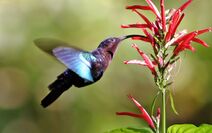
蜂鸟和喜鸟类(通过鸟类传粉)的花演化出了一种互惠的关系;这些花的花蜜合于鸟类的饮食,它们的颜色亦合于鸟类的视觉,它们的形状则合于鸟的喙;这些花的开放时间还被发现与蜂鸟的繁殖季节相吻合;同与被昆虫传粉密切相关的植物相比,喜鸟类植物的花部特征差异很大;这些花也会较昆虫授粉的同类更华丽、复杂和艳丽;被普遍认为的是,植物首先与昆虫形成共同演化关系,喜鸟类植物在后期分化;从鸟类学到昆虫授粉,并没有多少科学依据支持此分歧中相反的例子;喜鸟类植物花器官表型的多样性和蜜蜂传粉物种花器官表型的相对一致性可以归因于传粉者偏好的转变方向。[18]
花朵聚集在一起以利用同类鸟的优势;[19]花朵为了传粉者而相互竞争,而适应性减少了这种竞争的不利影响;鸟类可以在恶劣天气下飞行,这一事实使它们在蜜蜂和其他昆虫不活跃的地方成为更有效的授粉者;由于这个原因,鸟媒花在处在昆虫定居或植物较少的孤立环境中的冬季开放的花朵中更容易会出现;[19][20]鸟类传粉的花朵通常比昆虫传粉的花朵有更多的花蜜和更高的糖分产量。[21]这也正迎合了鸟类高能量的需求,作为了花在面临自然选择时最重要的决定因素[21];在沟酸浆属中,花瓣中红色素和花蜜产量的增加明显减少了蜜蜂授粉的比例,而对于蜂鸟则相反;同时花朵表面积越大蜜蜂授粉的比例也就越高;因此,红雀花中的红色色素可能主要起到抑制蜜蜂拜访的作用;[22]在钓钟柳中,阻碍蜜蜂授粉的花朵特征可能比“支持鸟类”的适应性对花朵进化变化的影响更大,但是“亲和”鸟类和“疏离”蜜蜂的适应性变化可以同时发生[23];然而,一些花,如海里康属的大鹤望兰似乎并不像人们想象的那样特别喜好鸟类:这个物种偶尔(在120小时的观察中被造访了151次)被无刺的无刺针属的蜜蜂拜访;在这种情况下,这些蜜蜂更多是作为了花粉盗窃者,但也可能充当传粉者。[24]
在各自的繁殖季节之后,几种蜂鸟出现在北美的同一地点,而这几种蜂鸟的花同时也在这些栖息地开放;这些花聚集在共同的一个形态和颜色,因为这些形态和颜色能够有效地吸引鸟类;花冠管长度和曲率的不同会影响与喙形态差异相关的蜂鸟物种的提取作用;管状花朵迫使鸟类在寻找花朵时以一种特殊的方式来调整喙的方向,尤其是当喙和花冠都是弯曲的时候;这允许了植物可以把花粉携于鸟身体的某一部分,从而实现了各种形态上的协同适应。[21]
喜鸟类的花需要引起鸟的注意;[21]鸟类的视觉光谱在红色一端拥有极好的色调辨别能力和最强的光谱敏感性[21],所以红色对它们来说特别显眼;蜂鸟可能也可以看到紫外线的“颜色”;在缺少花蜜的昆虫传粉的花朵中,紫外线图案和花蜜的流行会向导和警告鸟类去避开这些花;[21]蜂鸟的每两亚科——隐蜂鸟亚科(hermits)和蜂鸟亚科的每一个亚科都与一组特定的花一同演化;大多数种类与大型单子叶植物有关,而金线菊亚科更喜欢双子叶植物。[21]
无花果的生殖与无花果蜂
榕属植物由800种藤本植物、灌木和乔木构成,其中包括栽培的无花果、由它们可以保持雌花和花粉在其中的果实状萼的榕果所定义;每一种榕树都有自己的榕小蜂(在大多数情况下)为榕树授粉,由此一种贯穿于这个属中紧密的相互依赖关系已然形成并持续存在。[25]
相思树蚁与牛角相思树
相思树蚁(Pseudomyrmex ferruginea)是一种能保护至少5种“金合欢树”(Vachellia)免受食用牛角相思树的昆虫和其他植物争夺阳光的专性植物蚂蚁,而这种树则为这种蚂蚁及其幼虫提供营养和庇护[26][27];这种互利共生并不是自然而然的:其他蚂蚁种类遵循不同的进化策略,利用树木而不作回报;这些欺诈性的蚂蚁通过破坏树木的生殖器官对寄主施加重大伤害,不过它们对寄主健康的净影响并不一定是负面的,因此难以预测。[28][29]
宿主和寄生者
寄生者和有性生殖的宿主
宿主和寄生者的共同演化是宿主和寄生者的共同演化;[30]许多病毒作为专性寄生者的一个普遍特征是它们与各自宿主的共同演化;这两个物种之间的相关突变使它们进入了进化的军备竞赛;无论是哪种生物、宿主或寄生物,如果不能跟上其他生物的步伐,它们就会从它们的栖息地消失,而平均适合度较高的物种会幸存下来;这种竞争的假说被称为红皇后假说;[31]红皇后假说预测有性生殖可以让寄主在寄生者之前保持领先,就像爱丽丝镜中奇遇的红皇后比赛一样:“尽你所能跑而仍保留在同一个地方。”;[32]宿主进行有性繁殖,产生一些对寄生物具有免疫力的后代,然后进化为应对措施。[33]
寄生者和宿主的关系可能导致了有性生殖的流行,而不是更有效率的无性生殖;看起来,当寄生者感染宿主时,有性生殖提供了一个更好的机会来发展抵抗性(通过下一代的变异) ,这种可导致适应性的有性生殖变异性在无性生殖中则看不到,这样就更容易会产生另一代易受同一寄生者的感染的机体;[34][35][36]宿主和寄生者之间的共同演化可能相应导致了在普遍的群体中的许多遗传多样性,包括血浆多态性、蛋白多态性和组织相容性系统。[37]
巢穴寄生
巢穴寄生表明了宿主和寄生者密切的共同演化,例如一些杜鹃;这些鸟不自己筑巢,而是在其他物种的巢中产卵,排除或杀死寄主的卵和幼鸟,从而对寄主的生殖良性产生严重的负面影响;它们的卵伪装成它们寄主的卵,这意味寄主是能够区分自己的卵和入侵者的卵的,并且与杜鹃处于一种伪装和识别之间进化的军备竞赛中;杜鹃与寄主相反,具有加厚的蛋壳、较短的孵化期(所以它们的幼鸟会先孵化)和适于将蛋提出巢外的平脊等特征。[38][39][40]
拮抗性的共同演化
拮抗性的共同演化关系在收获蚁品种中的红收获蚁(Pogonomyrmex barbatus)和罗纹须蚁(Pogonomyrmex rugosus)之间可以看到,它们之间既有寄生关系也有互惠关系;蚁后无法通过与同类交配来繁殖工蚁;只有通过杂交,它们才能繁殖工蚁;有翅膀的雌性对其他物种的雄性像寄生一样,因为它们的精子只会繁殖不育的杂种;但由于殖民完全依赖于这些杂交种的生存,这也是互惠互利的;虽然两个物种之间没有基因交换,但它们不能朝向基因差异太大的方向演化,因为这将使杂交繁殖变得不可能。[41]
捕食者和猎物
捕食者和猎物互动并共同演化:捕食者去更有效地捕捉猎物,猎物去逃离追捕;两者的共同演化相互施加这一选择压;这往往导致猎物和捕食者之间的进化军备竞赛,并导致反捕食者适应。
这同样适用于草食动物、植食动物,以及它们吃的植物;1964年,保罗·R·欧里希和彼得·R·瑞文提出了逃逸和辐射的共同演化理论来描述植物和蝴蝶的进化多样性;[42]在落基山脉,红松鼠和斑鸠(食种子的鸟)争夺海滩松的种子;松鼠通过啃咬松果鳞片来获取松子,而斑鸠则通过它们不寻常的交叉下颚来获取松子;在有松鼠的地方,海滩松的球果更重、种子更少、鳞片更薄,这使得松鼠更加难以获取种子;相反,如果有斑鸠而没有松鼠,球果的结构会较轻,但有较厚的鳞片,从而就导致交喙更难获取种子;海滩上的锥形细胞与这两种食草动物进行着一场进化中的军备竞赛,在接下来的两个段落中也是这样。[43]
竞争行为
无论是具有如性对抗[44]和性选择[45]等特征的种内竞争,还是具有如食肉动物之间的种间竞争,都可能推动共同演化。[46]
种内竞争会导致性对抗的共同演化,这是一种类似于军备竞赛的进化关系;在这种关系中,两性的进化适应性被抵消以获得最大的繁殖成效;例如,一些昆虫使用创伤性的授精过程来繁殖,这对雌性的健康是不利的;在交配过程中,雄性试图通过尽可能多地为雌性授精来最大化自身交配的适配性,但雌性腹部的被刺穿次数越多,她生存的可能就越小,从而降低了她的适配性。[47]
多物种
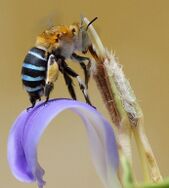
到目前为止,所列出的共同演化类型均是被描述为两两而作用的(也称为特定的共同演化)——其中一个物种的特征直接响应第二个物种特征而演化;反之亦然。然而现实当中所遇到的共同演化并非总是如此。另一种演化模式出现在相互演化之处,然而是在一组物种而不是两个物种之间;这被称作为泛协同性(集团性)的或散漫的共同演化。例如,几种被子植物例如在长管的末端提供花蜜的特征可以与一种或几种传粉昆虫例如长喙的特征共同演化;更一般地说,被子植物是由来自不同科的昆虫授粉的,包括蜜蜂、苍蝇和甲虫,所有这些昆虫形成了一个广泛的授粉者的协同系统,它们对花朵产生的花蜜或花粉作出反应。[47][48][49]
地理镶嵌理论
共同演化的地理镶嵌理论是由约翰·N·汤普森发展起来的,作为一种连接塑造生态系统中物种间互动的生态和进化过程的方式;它基于三个观察所得的假设:(1)这些物种通常是在基因上各所不同的种群,(2)互动的物种经常只是共同出现在它们地理范围的部分,以及(3)种间的互动在生态上发生分歧于环境的不同。
根据这些假设的地理镶嵌理论表明物种间相互作用的自然选择由三个变异来源驱动:
1.地理选择镶嵌发生在物种的相互作用之间;因为基因在不同的环境中以不同的方式表达,而且不同的基因会在不同的环境中各受欢迎。例如,寄生虫种群和宿主种群之间相互作用的自然选择在非常干燥的环境和非常湿润的环境之间可能有所不同;或者,两个或两个以上物种之间的相互作用在某些环境中可能是对抗性的,但在其他环境中是互惠性的(对两个或所有物种都有益)。
2. 共同演化的热点和冷点的出现是因为物种间相互作用的自然选择在某些环境中是相互的,而在其他环境中则不然;例如,一个共生的生物种群可能会损害其宿主在一个环境中的生存或繁殖,但它可能对宿主在另一个环境中的生存或繁殖没有影响;当这一影响是负面的时候,自然选择将有利于宿主种群的进化反应,从而导致寄生虫和宿主种群中正在进行的相互演变的共同演化热点;当共生对宿主的生存和繁殖没有影响时,共生生物种群的自然选择则会不利于宿主种群的进化反应(即共同演化的冷点)。
3. 最后,自然选择作用在局部和区域两方面的特征-不断-重新混合。在任何时候,当地的种群都会有一个自然选择作用的独特基因组合;这些种群之间的遗传差异之所以会出现,是因为每个当地种群都有新的突变、基因组的改变(例如全基因组复制)、来自其他种群个体或个体朝向其他种群的种间基因流、在种群规模较小时随机丢失或加强的基因(随机遗传漂变)、与其他种群的杂交,以及影响自然选择之作用的原始遗传物质的其他遗传和生态过程;更正式地说,共同演化的地理镶嵌可被看作是一种基因型与环境的相互作用(GxGxE),这种作用导致了相互作用物种的无向演化。
地理镶嵌理论已经通过广泛的数学模型、研究自然界中相互作用的物种,以及使用微生物物种和病毒的实验室实验得到探索。[5][2]
在生物学之外
共同演化是一个生物学的概念,但已经类推至其他领域。
在算法中
协同演化性的算法已经应用于生成人工生命;以及优化、博弈学习和机器学习等方面。[50][51][52][53][54]丹尼尔·希尔斯引进“共同进化寄生虫”防止优化过程陷入局部极大值。[55]卡尔·西姆斯将这一概念用至了虚拟生物上面。[56]
在建筑学中
共同进化的概念被丹麦建筑师兼城市规划专家亨利克 · 瓦勒尔在建筑学引入,作为“星架构”[57]的对立面;作为2006年威尼斯建筑双年展丹麦馆的馆长,他创建了一个关于中国城市发展共同进化的展览项目,并获得了最佳国家馆的金狮奖。[58][59][60][61]
在纽卡斯尔大学的建筑、规划和景观学院,共同进化方法的建筑学被定义为让学生、志愿者和当地社区的成员参与实际的、实验性的工作的一种设计实践,旨在“建立用户和设计师之间的动态学习过程”。[62]
在宇宙学和天文学中
在自组织的宇宙一书中,埃里希·詹茨把宇宙的整个演化归因于共同进化。
在天文学中,一个新兴的理论提出黑洞和星系以一种相互依存的方式生存,类似于生物的共同演化。[63]
在管理和组织研究中
自2000年以来,越来越多的管理和组织研究讨论共同演化和共同演化过程。即便这样,Abatecola等人(2020年)揭示了在解释这些领域在共同演化的基本特征方面的普遍缺乏,意味着关于这种社会经济变化的前景以及未来可能走向的具体分析仍然缺失。[64]
在社会学中
在发展的背叛:进步的终结和未来的共同演化修正(1994)[65]中,理查德·诺尔加尔提出了一个共同演化的宇宙学来解释社会和环境系统是如何相互影响和重塑的;[66]在共同演化经济学:经济、社会和环境(1994)中,约翰 · 高迪认为: “经济、社会和环境在共同进化的关系中联系在一起。”。[67]
在科技中
计算机软件和硬件可以被看作是两个独立而本质联系的成分;类似地,操作系统和计算机应用程序、网络浏览器和网络应用程序也是这样。
所有这些系统相互依存,通过一种演进过程一步一步前进。硬件、操作系统或网页浏览器的改变可能会引入新的功能,然后将这些功能合并到相应的应用程序中。[68]这个想法与社会技术系统分析和设计中的“联合优化”概念密切相关,在这个概念中,一个系统被理解为既包括用于生产和维护的工具和硬件的“技术系统”,也包括一个关系和程序的“社会系统”,通过这个系统,系统的目标以及系统内外的所有其他人和组织关系同技术联系在一起;当技术系统和社会系统被有意地共同发展时,这种系统工作得最好。[69]
也可以看看
注记
a.^The acacia ant protects at least 5 species of "Acacia", now all renamed to Vachellia: V. chiapensis, V. collinsii, V. cornigera, V. hindsii, and V. sphaerocephala.
参考文献
- ↑ 1.0 1.1 van der Pijl, Leendert; Dodson, Calaway H. (1966). "Chapter 11: Mimicry and Deception". Orchid Flowers: Their Pollination and Evolution. Coral Gables: University of Miami Press. pp. 129–141. ISBN 978-0-87024-069-0. https://archive.org/details/orchidflowersthe0000pijl.
- ↑ 2.0 2.1 Thompson, John N. (2013-04-15). Relentless evolution. Chicago. ISBN 978-0-226-01861-4. OCLC 808684836.
- ↑ 3.0 3.1 Nuismer, Scott (2017). Introduction to Coevolutionary Theory. New York: W.F. Freeman. p. 395. ISBN 978-1-319-10619-5. https://www.macmillanlearning.com/Catalog/product/introductiontocoevolutionarytheory-firstedition-nuismer/valueoptions.
- ↑ Guimarães, Paulo R.; Pires, Mathias M.; Jordano, Pedro; Bascompte, Jordi; Thompson, John N. (October 2017). "Indirect effects drive coevolution in mutualistic networks". Nature (in English). 550 (7677): 511–514. Bibcode:2017Natur.550..511G. doi:10.1038/nature24273. ISSN 1476-4687. PMID 29045396. S2CID 205261069.
- ↑ 5.0 5.1 Thompson, John N. (2005). The geographic mosaic of coevolution. Chicago: University of Chicago Press. ISBN 978-0-226-11869-7. OCLC 646854337.
- ↑ Futuyma, D. J. and M. Slatkin (editors) (1983). Coevolution. Sinauer Associates. pp. whole book. ISBN 978-0-87893-228-3.
- ↑ Thompson, J. N. (1994). The Coevolutionary Process. University of Chicago Press. pp. whole book. ISBN 978-0-226-79759-5.
- ↑ Friedman, W. E. (January 2009). "The meaning of Darwin's 'abominable mystery'". Am. J. Bot. 96 (1): 5–21. doi:10.3732/ajb.0800150. PMID 21628174.
- ↑ 9.0 9.1 Cardinal, Sophie; Danforth, Bryan N. (2013). "Bees diversified in the age of eudicots". Proceedings of the Royal Society B. 280 (1755): 20122686. doi:10.1098/rspb.2012.2686. PMC 3574388. PMID 23363629.
- ↑ Thompson, John N. (1994). The coevolutionary process. Chicago: University of Chicago Press. ISBN 978-0-226-79760-1. https://books.google.com/books?id=AyXPQzEwqPIC&q=Wallace+%22creation+by+law%22+Angr%C3%A6cum&pg=PA27.
- ↑ Darwin, Charles (1859). On the Origin of Species (1st ed.). London: John Murray. http://darwin-online.org.uk/content/frameset?itemID=F373&viewtype=text&pageseq=1.
- ↑ Darwin, Charles (1877). On the various contrivances by which British and foreign orchids are fertilised by insects, and on the good effects of intercrossing (2nd ed.). London: John Murray. http://darwin-online.org.uk/content/frameset?itemID=F801&viewtype=text&pageseq=1.
- ↑ Lunau, Klaus (2004). "Adaptive radiation and coevolution — pollination biology case studies". Organisms Diversity & Evolution. 4 (3): 207–224. doi:10.1016/j.ode.2004.02.002.
- ↑ Pollan, Michael (2003). The Botany of Desire: A Plant's-eye View of the World. Bloomsbury. ISBN 978-0-7475-6300-6.
- ↑ 15.0 15.1 15.2 "Coevolution of angiosperms and insects". University of Bristol Palaeobiology Research Group. Archived from the original on 20 December 2016. Retrieved 16 January 2017.
- ↑ Hemingway, Claire (2004). "Pollination Partnerships Fact Sheet" (PDF). Flora of North America: 1–2. Retrieved 2011-02-18.
Yucca and Yucca Moth
- ↑ Pellmyr, Olle; James Leebens-Mack (August 1999). "Forty million years of mutualism: Evidence for Eocene origin of the yucca-yucca moth association". Proc. Natl. Acad. Sci. USA. 96 (16): 9178–9183. Bibcode:1999PNAS...96.9178P. doi:10.1073/pnas.96.16.9178. PMC 17753. PMID 10430916.
- ↑ Kay, Kathleen M.; Reeves, Patrick A.; Olmstead, Richard G.; Schemske, Douglas W. (2005). "Rapid speciation and the evolution of hummingbird pollination in neotropical Costus subgenus Costus (Costaceae): evidence from nrDNA ITS and ETS sequences". American Journal of Botany. 92 (11): 1899–1910. doi:10.3732/ajb.92.11.1899. PMID 21646107. S2CID 2991957.
- ↑ 19.0 19.1 Brown James H.; Kodric-Brown Astrid (1979). "Convergence, Competition, and Mimicry in a Temperate Community of Hummingbird-Pollinated Flowers". Ecology. 60 (5): 1022–1035. doi:10.2307/1936870. JSTOR 1936870. S2CID 53604204.
- ↑ Cronk, Quentin; Ojeda, Isidro (2008). "Bird-pollinated flowers in an evolutionary and molecular context". Journal of Experimental Botany. 59 (4): 715–727. doi:10.1093/jxb/ern009. PMID 18326865.
- ↑ 21.0 21.1 21.2 21.3 21.4 21.5 21.6 Stiles, F. Gary (1981). "Geographical Aspects of Bird Flower Coevolution, with Particular Reference to Central America". Annals of the Missouri Botanical Garden. 68 (2): 323–351. doi:10.2307/2398801. JSTOR 2398801.
- ↑ Schemske, Douglas W.; Bradshaw, H.D. (1999). "Pollinator preference and the evolution of floral traits in monkeyflowers (Mimulus)". Proceedings of the National Academy of Sciences. 96 (21): 11910–11915. Bibcode:1999PNAS...9611910S. doi:10.1073/pnas.96.21.11910. PMC 18386. PMID 10518550.
- ↑ Castellanos, M. C.; Wilson, P.; Thomson, J.D. (2005). "'Anti-bee' and 'pro-bird' changes during the evolution of hummingbird pollination in Penstemon flowers". Journal of Evolutionary Biology. 17 (4): 876–885. doi:10.1111/j.1420-9101.2004.00729.x. PMID 15271088.
- ↑ Stein, Katharina; Hensen, Isabell (2011). "Potential Pollinators and Robbers: A Study of the Floral Visitors of Heliconia Angusta (Heliconiaceae) And Their Behaviour". Journal of Pollination Ecology. 4 (6): 39–47. doi:10.26786/1920-7603(2011)7.
- ↑ 25.0 25.1 Suleman, Nazia; Sait, Steve; Compton, Stephen G. (2015). "Female figs as traps: Their impact on the dynamics of an experimental fig tree-pollinator-parasitoid community" (PDF). Acta Oecologica. 62: 1–9. Bibcode:2015AcO....62....1S. doi:10.1016/j.actao.2014.11.001.
- ↑ 26.0 26.1 Hölldobler, Bert; Wilson, Edward O. (1990). The ants. Harvard University Press. pp. 532–533. ISBN 978-0-674-04075-5. https://archive.org/details/ants0000hlld.
- ↑ National Geographic. "Acacia Ant Video". Archived from the original on 2007-11-07.
- ↑ Palmer TM, Doak DF, Stanton ML, Bronstein JL, Kiers ET, Young TP, Goheen JR, Pringle RM (2010). "Synergy of multiple partners, including freeloaders, increases host fitness in a multispecies mutualism". Proceedings of the National Academy of Sciences of the United States of America. 107 (40): 17234–9. Bibcode:2010PNAS..10717234P. doi:10.1073/pnas.1006872107. PMC 2951420. PMID 20855614.
- ↑ Mintzer, Alex; Vinson, S.B. (1985). "Kinship and incompatibility between colonies of the acacia ant Pseudomyrex ferruginea". Behavioral Ecology and Sociobiology. 17 (1): 75–78. doi:10.1007/bf00299432. JSTOR 4599807. S2CID 9538185.
- ↑ Woolhouse, M. E. J.; Webster, J. P.; Domingo, E.; Charlesworth, B.; Levin, B. R. (December 2002). "Biological and biomedical implications of the coevolution of pathogens and their hosts" (PDF). Nature Genetics. 32 (4): 569–77. doi:10.1038/ng1202-569. hdl:1842/689. PMID 12457190. S2CID 33145462.
- ↑ Van Valen, L. (1973). "A New Evolutionary Law". Evolutionary Theory. 1: 1–30. cited in: The Red Queen Principle
- ↑ Carroll, Lewis (1875). Through the Looking-glass: And what Alice Found There. Macmillan. p. 42. https://books.google.com/books?id=cJJZAAAAYAAJ. "it takes all the running you can do, to keep in the same place."
- ↑ Rabajante, J.; et al. (2015). "Red Queen dynamics in multi-host and multi-parasite interaction system". Scientific Reports. 5: 10004. Bibcode:2015NatSR...510004R. doi:10.1038/srep10004. PMC 4405699. PMID 25899168.
- ↑ "Sexual reproduction works thanks to ever-evolving host, parasite relationships". PhysOrg. 7 July 2011.
- ↑ Morran, L.T.; Schmidt, O.G.; Gelarden, I.A.; Parrish, R.C. II; Lively, C.M. (8 July 2011). "Running with the Red Queen: Host-Parasite Coevolution Selects for Biparental Sex". Science. 333 (6039): 216–8. Bibcode:2011Sci...333..216M. doi:10.1126/science.1206360. PMC 3402160. PMID 21737739. Science.1206360.
- ↑ Hogan, C. Michael (2010). "Virus". In Cutler Cleveland; Sidney Draggan (eds.). Encyclopedia of Earth.
- ↑ Anderson, R.; May, R. (October 1982). "Coevolution of hosts and parasites". Parasitology. 85 (2): 411–426. doi:10.1017/S0031182000055360. PMID 6755367.
- ↑ 38.0 38.1 Weiblen, George D. (May 2003). "Interspecific Coevolution" (PDF). Macmillan.
- ↑ Rothstein, S.I (1990). "A model system for coevolution: avian brood parasitism". Annual Review of Ecology and Systematics. 21: 481–508. doi:10.1146/annurev.ecolsys.21.1.481.
- ↑ Davies, N. B. (Nicholas B.), 1952- (7 April 2015). Cuckoo : cheating by nature. McCallum, James (Wildlife artist) (First U.S. ed.). New York, NY. ISBN 978-1-62040-952-7. OCLC 881092849.
- ↑ Herrmann, M.; Cahan, S. H. (29 October 2014). "Inter-genomic sexual conflict drives antagonistic coevolution in harvester ants". Proceedings of the Royal Society B: Biological Sciences. 281 (1797): 20141771. doi:10.1098/rspb.2014.1771. PMC 4240986. PMID 25355474.
- ↑ Ehrlich, Paul R.; Raven, Peter H. (1964). "Butterflies and Plants: A Study in Coevolution". Evolution. 18 (4): 586–608. doi:10.2307/2406212. JSTOR 2406212.
- ↑ "Coevolution". University of California Berkeley. Retrieved 17 January 2017. and the two following pages of the web article.
- ↑ Parker, G. A. (2006). "Sexual conflict over mating and fertilization: An overview". Philosophical Transactions of the Royal Society B: Biological Sciences. 361 (1466): 235–59. doi:10.1098/rstb.2005.1785. PMC 1569603. PMID 16612884.
- ↑ "Biol 2007 - Coevolution". University College, London. Retrieved 19 January 2017.
- ↑ Connell, Joseph H. (October 1980). "Diversity and the Coevolution of Competitors, or the Ghost of Competition Past". Oikos. 35 (2): 131–138. doi:10.2307/3544421. JSTOR 3544421. S2CID 5576868.
- ↑ 47.0 47.1 47.2 Juenger, Thomas, and Joy Bergelson. "Pairwise versus diffuse natural selection and the multiple herbivores of scarlet gilia, Ipomopsis aggregata." Evolution (1998): 1583–1592.
- ↑ Gullan, P. J.; Cranston, P. S. (2010). The Insects: An Outline of Entomology (4th ed.). Wiley. pp. 291–293. ISBN 978-1-118-84615-5. https://archive.org/details/insectsoutlineen00pjgu.
- ↑ Rader, Romina; Bartomeus, Ignasi; et al. (2016). "Non-bee insects are important contributors to global crop pollination". PNAS. 113 (1): 146–151. Bibcode:2016PNAS..113..146R. doi:10.1073/pnas.1517092112. PMC 4711867. PMID 26621730.
- ↑ Potter M. and K. De Jong, Evolving Complex Structures via Cooperative Coevolution, Fourth Annual Conference on Evolutionary Programming, San Diego, CA, 1995.
- ↑ Potter M., The Design and Computational Model of Cooperative Coevolution, PhD thesis, George Mason University, Fairfax, Virginia, 1997.
- ↑ Potter, Mitchell A.; De Jong, Kenneth A. (2000). "Cooperative Coevolution: An Architecture for Evolving Coadapted Subcomponents". Evolutionary Computation. 8 (1): 1–29. CiteSeerX 10.1.1.134.2926. doi:10.1162/106365600568086. PMID 10753229. S2CID 10265380.
- ↑ Weigand P., Liles W., De Jong K., An empirical analysis of collaboration methods in cooperative coevolutionary algorithms. Proceedings of the Genetic and Evolutionary Computation Conference (GECCO) 2001.
- ↑ Weigand P., An Analysis of Cooperative Coevolutionary Algorithms, PhD thesis, George Mason University, Fairfax, Virginia, 2003.
- ↑ Hillis, W.D. (1990), "Co-evolving parasites improve simulated evolution as an optimization procedure", Physica D: Nonlinear Phenomena, 42 (1–3): 228–234, Bibcode:1990PhyD...42..228H, doi:10.1016/0167-2789(90)90076-2
- ↑ Sims, Karl (1994). "Evolved Virtual Creatures". Karl Sims. Retrieved 17 January 2017.
- ↑ "Henrik Valeur's biography". Retrieved 2015-08-29.
- ↑ "About Co-evolution". Danish Architecture Centre. Archived from the original on 2015-11-20. Retrieved 2015-08-29.
- ↑ "An interview with Henrik Valeur". Movingcities. 2007-12-17. Retrieved 2015-10-17.
- ↑ Valeur, Henrik (2006). Co-evolution: Danish/Chinese Collaboration on Sustainable Urban Development in China. Copenhagen: Danish Architecture Centre. p. 12. ISBN 978-87-90668-61-7.
- ↑ Valeur, Henrik (2014). India: the Urban Transition - a Case Study of Development Urbanism. Architectural Publisher B. p. 22. ISBN 978-87-92700-09-4.
- ↑ Farmer, Graham (2017). "From Differentiation to Concretisation: Integrative Experiments in Sustainable Architecture". Societies. 3 (35): 18. doi:10.3390/soc7040035.
- ↑ Gnedin, Oleg Y.; et al. (2014). "Co-Evolution of Galactic Nuclei and Globular Cluster Systems". The Astrophysical Journal. 785 (1): 71. arXiv:1308.0021. Bibcode:2014ApJ...785...71G. doi:10.1088/0004-637X/785/1/71. S2CID 118660328.
- ↑ Abatecola, Gianpaolo; Breslin, Dermot; Kask, Johan (2020). "Do organizations really co-evolve? Problematizing co-evolutionary change in management and organization studies". Technological Forecasting and Social Change. 155: 119964. doi:10.1016/j.techfore.2020.119964. ISSN 0040-1625.
- ↑ Norgaard, Richard B. (1994). Development Betrayed: The End of Progress and a Coevolutionary Revisioning of the Future. Routledge.
- ↑ Glasser, Harold (1996). "Development Betrayed: The End of Progress and A Coevolutionary Revisioning of the Future by Richard B. Norgaard". Environmental Values. 5 (3): 267–270. JSTOR 30301478.
- ↑ Gowdy, John (1994). Coevolutionary Economics: The Economy, Society and the Environment. Springer. pp. 1–2.
- ↑ Theo D'Hondt, Kris De Volder, Kim Mens and Roel Wuyts, Co-Evolution of Object-Oriented Software Design and Implementation, TheKluwer International Series in Engineering and Computer Science, 2002, Volume 648, Part 2, 207–224 doi:10.1007/978-1-4615-0883-0_7
- ↑ Cherns, A. (1976). "The principles of sociotechnical design". Human Relations. 29 (8): 8. doi:10.1177/001872677602900806.
外部链接
- 共同演化,史蒂芬 C. 斯特恩斯的讲座视频(耶鲁大学开放课程)
类别: 生态过程类别: 环境术语类别: 生物圈的进化类别: 进化生物学类别: 栖息地
This page was moved from wikipedia:en:Coevolution. Its edit history can be viewed at 共同演化/edithistory
